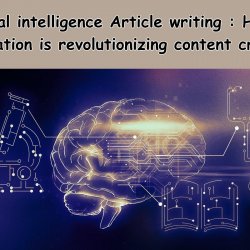What Is ChatGPT? Everything You Want to Be Aware

 What is ChatGPT?
What is ChatGPT?
Chatbots have become an increasingly popular tool for businesses and individuals alike. However, the introduction of ChatGPT has taken chatbots to a whole new level. But what exactly is ChatGPT? In this blog section, we will delve into the concepts and capabilities of this AIbased chatbot platform.
First and foremost, it is important to understand that ChatGPT stands for “Chat Generative Pretrained Transformer”. This may sound like a mouthful, but essentially it is an advanced form of Artificial Intelligence (AI) technology that utilizes Natural Language Processing (NLP) techniques. In simpler terms, ChatGPT is a chatbot that can understand and respond to human language in a conversational manner.
What sets ChatGPT apart from other chatbots is its advanced conversational abilities. Unlike rule based chat bots that follow predetermined scripts, ChatGPT has been trained on vast amounts of data from various sources such as books, articles, and online conversations. This allows the bot to generate humanlike responses and adapt to different conversational styles.
Additionally, one of the key advantages of using ChatGPT is its ability to understand context. This means that the bot can comprehend the meaning behind words rather than just responding based on keywords. For example, if someone asks “What’s the weather like?”, ChatGPT can infer that they are asking about the current climate in their location rather than just providing a general weather forecast.
How does Chat GPT work?
- Pre-training: GPT is trained on a massive dataset that includes a diverse range of text from the internet, such as books, articles, and websites. During this pre-training phase, the model learns to understand the structure and patterns of human language.
- Tokenization: When given an input, GPT tokenizes the text, breaking it down into smaller units that the model can process more efficiently. These units are typically words or subwords, allowing the model to analyze and understand the sequence of words in the input.
- Processing with Transformer Architecture: GPT uses the transformer architecture, which enables it to process and generate text by paying attention to the contextual relationships between words in a sentence. This architecture allows the model to consider the entire context of the input, rather than just the preceding or succeeding words.
- Generating Responses: GPT generates responses based on the input it receives and the patterns it has learned during the pre-training phase. It predicts the most probable sequence of words that follow the input, generating coherent and contextually relevant text as a response.
- Fine-tuning and Adaptation: GPT can be fine-tuned on specific datasets to adapt its responses to particular domains or tasks. This allows users to tailor the model’s capabilities to specific applications, such as customer support, content creation, or information retrieval.
- Continual Learning: GPT can continually improve its performance through exposure to new data and user interactions. This continual learning process helps the model adapt to new language patterns and stay up-to-date with evolving linguistic trends and changes in human communication.
Features of ChatGPT
- Natural language processing (NLP): ChatGPT is capable of understanding and generating human-like text, allowing it to engage in seamless and coherent conversations with users.
- Context awareness: The model can maintain context over multiple turns of conversation, enabling it to provide relevant and contextually appropriate responses based on the preceding dialogue.
- Content generation: ChatGPT can generate a diverse range of content, including text for articles, stories, essays, and other forms of written communication, based on the provided prompts and instructions.
- Multimodal capabilities: GPT-3 has the potential to integrate with and process various forms of multimedia, including images and videos, expanding its ability to understand and generate content across different modalities.
- Task completion and assistance: ChatGPT can assist users with a variety of tasks, such as providing information, answering questions, offering explanations, and performing basic language-based functions.
- Contextual understanding: The model can interpret and respond to complex queries by considering the context and nuances of the provided input, allowing it to generate relevant and meaningful responses in various conversational contexts.
- Adaptability and customization: GPT-3 can be fine-tuned and customized for specific applications and domains, enabling users to tailor its capabilities to suit specific tasks and use cases.
Benefits of using ChatGPT
- 24/7 availability: ChatGPT can provide assistance and information round the clock, ensuring that users have access to support and resources whenever they need them, regardless of the time of day.
- Scalability: ChatGPT can handle multiple user inquiries simultaneously, making it highly scalable and capable of managing large volumes of queries and interactions efficiently.
- Cost-effectiveness: Implementing ChatGPT can be a cost-effective solution for businesses, as it reduces the need for human customer support agents to handle routine inquiries and tasks, thus optimizing resource allocation and reducing operational costs.
- Consistent customer service: ChatGPT can provide consistent and standardized responses to user queries, ensuring that customers receive uniform and reliable information and support across various communication channels.
- Enhanced user engagement: ChatGPT can engage users in meaningful and personalized conversations, providing them with relevant information, recommendations, and guidance tailored to their specific needs and preferences.
- Quick information retrieval: ChatGPT can swiftly retrieve and deliver relevant information, reducing the time and effort required for users to access the data or resources they require.
- Language translation and support: ChatGPT can facilitate communication across different languages, providing real-time translation services and enabling users to interact seamlessly regardless of language barriers.
- Data analysis and insights: ChatGPT can gather and analyze user data and interactions, providing valuable insights into user preferences, behaviors, and trends, which can be used to improve products, services, and overall user experiences.
Limitations and criticisms of ChatGPT
- Lack of understanding of context: ChatGPT may sometimes struggle to fully grasp the context of complex or ambiguous queries, leading to responses that are not entirely relevant or accurate.
- Tendency to generate nonsensical or inappropriate content: In some cases, ChatGPT may produce irrelevant, nonsensical, or inappropriate content, especially when presented with ambiguous or controversial topics, potentially leading to misinformation or confusion.
- Inability to comprehend nuanced or emotional language: ChatGPT may have difficulty understanding and responding to nuanced or emotionally charged language, leading to responses that lack empathy or fail to address the underlying sentiment of the user’s message.
- Propagation of biases and misinformation: ChatGPT can inadvertently perpetuate biases and misinformation present in the data it was trained on, potentially leading to the spread of false or biased information during interactions with users.
- Lack of real-world knowledge and experience: ChatGPT may lack real-world knowledge and experiences, limiting its ability to provide practical advice or solutions that require a deep understanding of real-life contexts and scenarios.
Alternatives to Chat GPT
- Microsoft’s Azure Bot Service: This service provides tools and services for creating intelligent, enterprise-grade bots that can interact with users across various channels, including websites, apps, and messaging platforms.
- IBM Watson Assistant: IBM Watson Assistant is a robust AI-powered virtual agent that enables businesses to build and deploy conversational interfaces into applications and devices.
- Amazon Lex: Amazon Lex is a service for building conversational interfaces into any application using voice and text. It provides advanced deep learning functionalities for natural language understanding and automatic speech recognition.
- Google’s Dialog Flow: Dialog Flow is a development suite for creating conversational interfaces such as chatbots and voice applications. It offers natural language understanding and a wide range of integrations with popular messaging platforms.
- Rasa: Rasa is an open-source conversational AI platform that allows developers to build and deploy AI-powered chatbots and virtual assistants. It provides tools for natural language understanding, dialogue management, and integration with various messaging channels.
- Wit.ai: Wit.ai, owned by Facebook, is a natural language processing platform that enables developers to create text or voice-based interfaces for applications and devices. It offers robust tools for building chatbots and voice-controlled applications.
- Pandorabots: Pandorabots is a platform that allows developers to build and deploy AI chatbots for various use cases, including customer service, marketing, and entertainment. It offers tools for natural language understanding and conversation management.
- Chatfuel: Chatfuel is a popular chatbot development platform that simplifies the process of creating AI-powered chatbots for Facebook Messenger and other messaging platforms. It offers a user-friendly interface and various integrations for easy deployment.
You can also read:
star agile data science reviews






Ingen kommentarer endnu